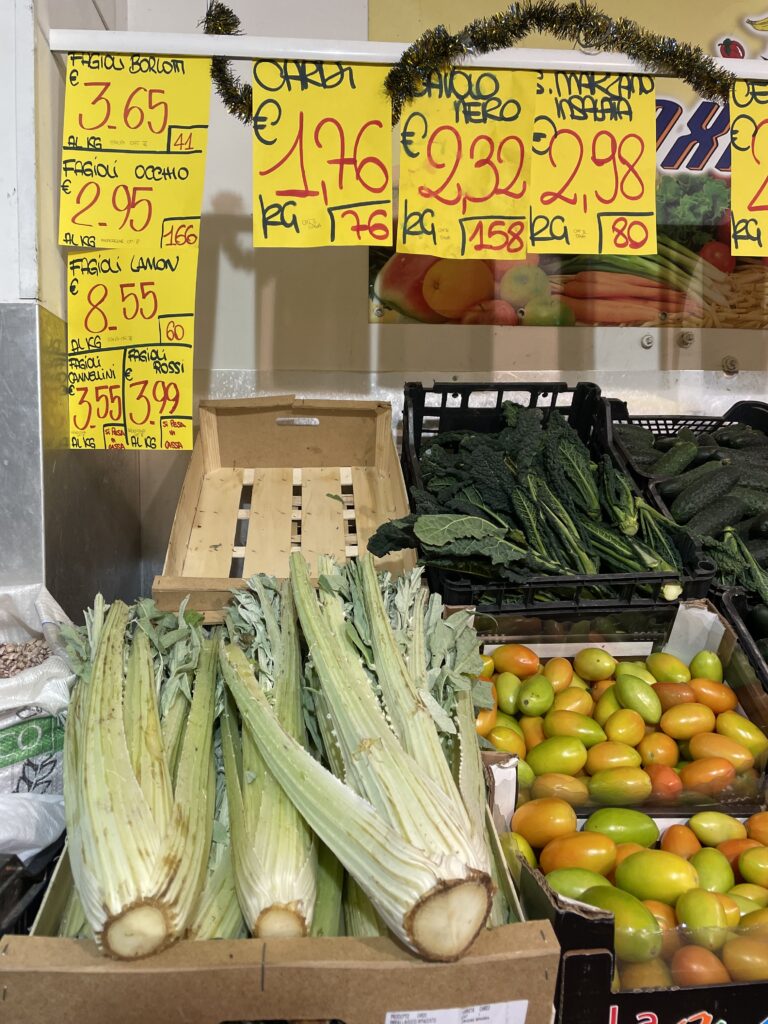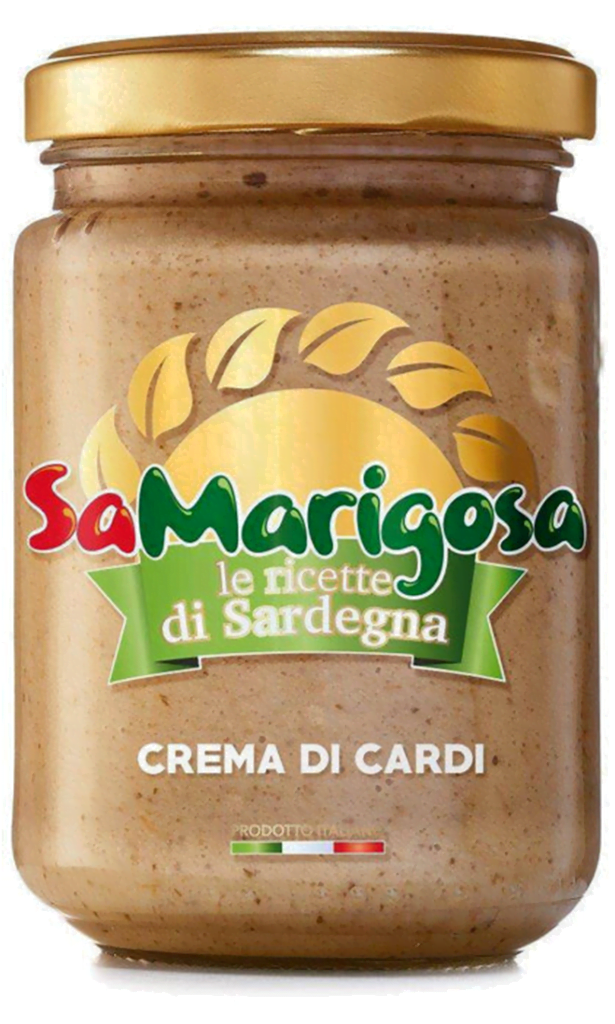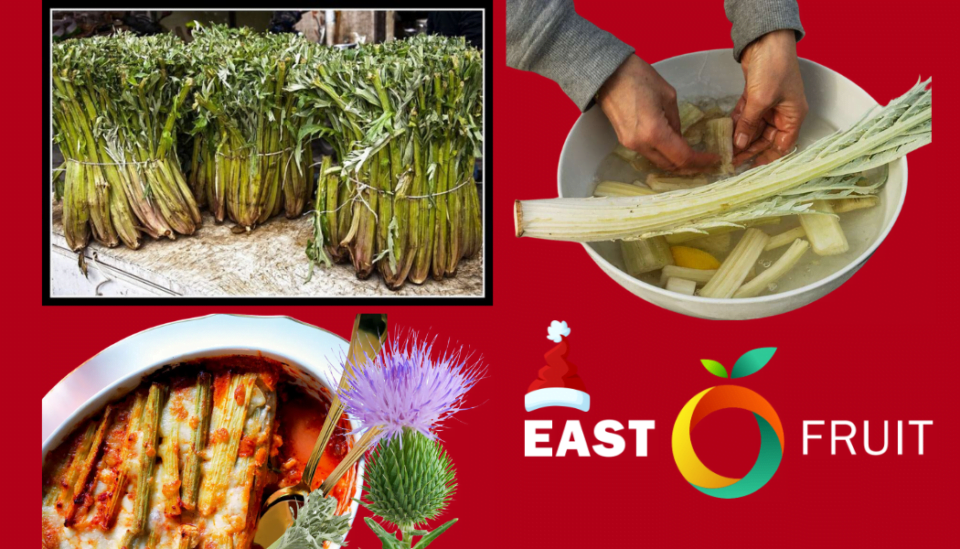Cardoon, also known as artichoke thistle, cardy, gobbo, or Cynara cardunculus var. Altilis, is an ancient plant with large stems and bright flowers. Resembling celery in shape, it is a winter vegetable related to the artichoke family and shares kinship with burdock, milk thistle, and wild artichoke.
 Cardoon is harvested in Mediterranean countries from October to March, possessing nutritional properties and serving as a foundation for many traditional recipes, especially during winter in Mediterranean countries. Its cultivation is widespread in Italy, Spain, and France, while it is less common and known in other parts of the world, being grown in Argentina and Australia, as reported by EastFruit. The cardy variety, “Monferrato,” is particularly renowned for its typical curved shape and tender white stems.
Cardoon is harvested in Mediterranean countries from October to March, possessing nutritional properties and serving as a foundation for many traditional recipes, especially during winter in Mediterranean countries. Its cultivation is widespread in Italy, Spain, and France, while it is less common and known in other parts of the world, being grown in Argentina and Australia, as reported by EastFruit. The cardy variety, “Monferrato,” is particularly renowned for its typical curved shape and tender white stems.
 “During this Christmas and New Year’s season, cardoon stems are sold everywhere in Italy for preparing risottos and baked vegetable dishes. In the Veneto region, the cost of cardoon stems in fruit and vegetable stores is €1.76 per kilogram,” notes Kateryna Zvierieva, the head of the website of the International information and analytical platform EastFruit, and the director of the Ukrainian Horticulture Association.
“During this Christmas and New Year’s season, cardoon stems are sold everywhere in Italy for preparing risottos and baked vegetable dishes. In the Veneto region, the cost of cardoon stems in fruit and vegetable stores is €1.76 per kilogram,” notes Kateryna Zvierieva, the head of the website of the International information and analytical platform EastFruit, and the director of the Ukrainian Horticulture Association.
 Cardoon belongs to the Asteraceae family, a perennial herbaceous plant that remains dormant during dry seasons and becomes active in winter months when water reserves are ample. Compared to its wild relative, cardoon is larger, with long, soft ribs and sturdier outer stems, sometimes covered with spines. When preparing dishes, the outer parts are peeled, removing all leaves, while the more tender and flavourful inner part is preserved, occasionally removing larger “ribs” on the stems if necessary.
Cardoon belongs to the Asteraceae family, a perennial herbaceous plant that remains dormant during dry seasons and becomes active in winter months when water reserves are ample. Compared to its wild relative, cardoon is larger, with long, soft ribs and sturdier outer stems, sometimes covered with spines. When preparing dishes, the outer parts are peeled, removing all leaves, while the more tender and flavourful inner part is preserved, occasionally removing larger “ribs” on the stems if necessary.

“Cardoon is often grown, partially burying it in soil. As it grows, seeking light, the plant bends, and for this reason, in many regions of Italy, cardoon is called hunchbacked,” explains Kateryna Zvereva.
Origin of the Hunchbacked Thistle:
It is believed that the Greeks and Romans cultivated cardoon, but the first historical traces date back to 1600 when cardoon specimens appeared in still lifes painted by renowned Italian and Spanish artists.
 “Still Life with Cardoon” — Caravaggio, 1590
“Still Life with Cardoon” — Caravaggio, 1590
In the painting, cardoon stems are clearly visible in the upper right, marking one of the earliest pieces of evidence of the existence of this vegetable. Juan Sánchez Cotán, Prado Museum.
 The cardoon’s brother, thistle, is a symbol of Scotland. In 1470, during the reign of James III, the image of thistle was stamped on silver coins, and from the 16th century, it appeared on the coat of arms of Scotland. According to legend, it saved Scottish warriors from a Viking attack, as one of the invaders stepped on the thistle, covered in prickles, and cried out, waking all the sleeping Scots, who were able to repel the enemy in time.
The cardoon’s brother, thistle, is a symbol of Scotland. In 1470, during the reign of James III, the image of thistle was stamped on silver coins, and from the 16th century, it appeared on the coat of arms of Scotland. According to legend, it saved Scottish warriors from a Viking attack, as one of the invaders stepped on the thistle, covered in prickles, and cried out, waking all the sleeping Scots, who were able to repel the enemy in time.
Nutritional Properties of Cardoon:
In 100 grams of cardoon stems, there are approximately twenty calories. Carbohydrates make up about 4 grams, fiber about 2 grams, proteins only one gram, with almost negligible fat content. It contains satisfactory amounts of folates, vitamin B6, and vitamin C. It is rich in manganese, copper, potassium, magnesium, and sodium. The characteristic bitter taste is due to the high content of binding compounds, especially phenols, causing the stems of the hunchbacked thistle to darken quickly when cut.
Phenolic compounds also contribute to the rigidity of cell walls; the fibers of cardoon are so hard and sturdy that they need to be manually removed or boiled several times to gradually soften the stems.
In the extract of thistle flowers, typically wild thistle, special enzymes, primarily proteases, are found. These enzymes are used as plant-based enzymes for cheese production in Portugal’s Serra da Estrela and Serpa, as well as in Spain’s Torta del Casar.
 “It’s interesting that in Italy, the Veggie Med Cheeses project is underway, focusing on the production of traditional cheeses using thistle rennet instead of animal-derived rennet.
“It’s interesting that in Italy, the Veggie Med Cheeses project is underway, focusing on the production of traditional cheeses using thistle rennet instead of animal-derived rennet.
Currently, new products are being developed within the context of sustainable production methods and based on local traditional recipes. All produced cheeses are analyzed from a physicochemical, chemical, microbiological, structural, colorimetric, and sensory perspective. According to research, the production of rennet with hunchbacked thistle is more sustainable and economically advantageous compared to animal-derived rennet. Additionally, the resulting cheese can be consumed by those adhering to a vegetarian diet. This allows for the introduction of new products, always connected to tradition, into the vegetarian product market segment (which tends to grow in terms of consumption), fostering a new economy in rural areas of the Mediterranean,” notes Kateryna Zvierieva.
Among the new alternative vegetarian products are two typical Mediterranean cheeses traditionally produced using animal-derived rennet: Feta, the famous Greek cheese made from fresh sheep’s and goat’s milk, and “Queso de Murcia,” a typical Spanish cheese made from goat’s milk.

“At present, there are no specific scientific studies on thistle and its components. However, the abundant phenolic component present in the extracts makes them an interesting subject for studying their antioxidant activity. Another researched compound is cynarin, which in several studies has shown that it can cause a significant reduction in cholesterol.
How to consume cardoon:
 Some eat the tender, albeit prickly, young flowers of thistle. Some use these flowers to make tea. However, in most cases, it’s the thistle stems that are consumed as food.
Some eat the tender, albeit prickly, young flowers of thistle. Some use these flowers to make tea. However, in most cases, it’s the thistle stems that are consumed as food.
When buying, it’s best to choose thistles with firm, wide, never soft, white, and curved ribs. Avoid green ribs, as they are tough, fibrous, and bitter. Thistles can be stored for one to two weeks in the refrigerator, preferably wrapped in paper. Avoid freezing, as it completely ruins the product’s characteristics.
Thistles should be cleaned before cooking by removing the harder outer ribs and eliminating larger, tougher fibers from the softer ribs. After cleaning, trim the ribs and cut them into pieces about ten centimeters long. To prevent them from darkening due to the interaction of air with phenolic compounds, simply immerse them in water with a little lemon juice. Pieces prepared in this way are usually scalded with boiling water to remove some compounds that give a bitter taste and make them even more tender. Thistles prepared in this way can be used right away or stored in the refrigerator for several days.

In Eastern European countries, the consumption of hunchbacked thistle stems is not widespread. It seems that this vegetable is only appreciated by the Portuguese, Spaniards, French, and Italians, who have made it an important element of the table in winter months.
 In Spain, for example, it is eaten boiled with almond sauce. It is often served with sauces or as part of a gratin, pan-fried, or mashed with other vegetables. Given the strength of the fibers, they are well suited for deep frying, as well as for adding to soups and stews. Italian cuisine is full of recipes that include the use of cardoon, and practically every region has its typical dish involving the use of this tough vegetable.
In Spain, for example, it is eaten boiled with almond sauce. It is often served with sauces or as part of a gratin, pan-fried, or mashed with other vegetables. Given the strength of the fibers, they are well suited for deep frying, as well as for adding to soups and stews. Italian cuisine is full of recipes that include the use of cardoon, and practically every region has its typical dish involving the use of this tough vegetable.
 In Molise, they make soups from cardoons, and in Romagna, they stew them, frying them in lard. In Tuscany, they eat them in a gratin or with Parmesan, and in Campania, they even play a starring role in the first Christmas dishes, such as ‘Cardone Beneventano,’ a rich soup with meat and eggs.
In Molise, they make soups from cardoons, and in Romagna, they stew them, frying them in lard. In Tuscany, they eat them in a gratin or with Parmesan, and in Campania, they even play a starring role in the first Christmas dishes, such as ‘Cardone Beneventano,’ a rich soup with meat and eggs.
 Cardoon is also eaten with anchovy sauce, one of the many variations of Piedmontese ‘Bagna Cauda,’ an exquisite dish based on anchovies, garlic, vegetable and butter, served hot with a mix of vegetables, among which ‘Gobbo di Monferrato’ must always be present. In Veneto, cardoon is baked with sauces, and risotto is prepared with it.
Cardoon is also eaten with anchovy sauce, one of the many variations of Piedmontese ‘Bagna Cauda,’ an exquisite dish based on anchovies, garlic, vegetable and butter, served hot with a mix of vegetables, among which ‘Gobbo di Monferrato’ must always be present. In Veneto, cardoon is baked with sauces, and risotto is prepared with it.

In Mediterranean countries, cardoons are also used to make sauces, pickles, and are served as appetizers. Liqueurs and creams are also made with them.
They are even added to Christmas cakes — panettone!





